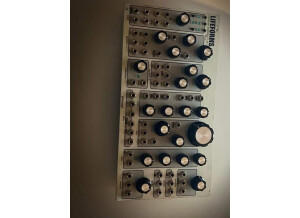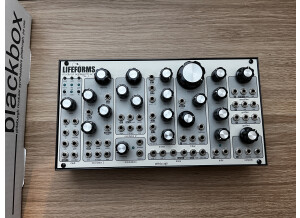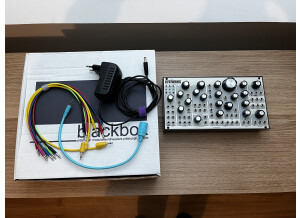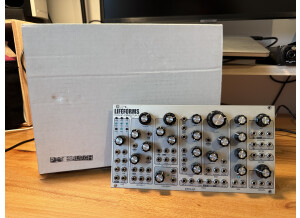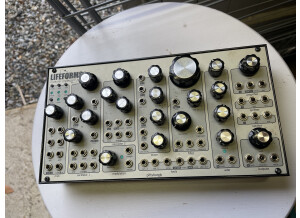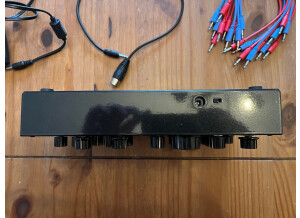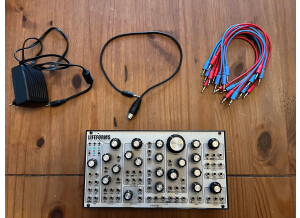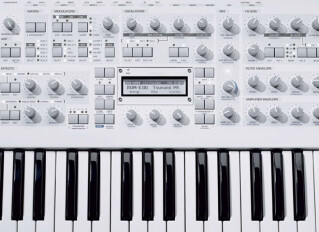Annonces Lifeforms SV-1
Alerte nouvelle annonceForums Pittsburgh Modular Lifeforms SV-1
News
Images
Tutoriels et astuces
Vidéos
Avis
STABLE
Publié le 08/09/21 à 09:08Pour les caractéristiques techniques : lire les spécifications sur le site du constructeur.
https://pittsburghmodular.com/lifeforms-sv-1
Par contre, contrairement à l’avis précédent (très complet d’ailleurs) je n’ai absolument aucun problème de tracking. Le module est super stable sur plein d’octaves (test fait avec un accordeur ultra précis). Il a probablement été calibré correctement. Donc ce module tiens parfaitement l’accord et je confirme les enveloppes sont très rapides et claquantes.
Un super module très complet.…
Pour les caractéristiques techniques : lire les spécifications sur le site du constructeur.
https://pittsburghmodular.com/lifeforms-sv-1
Par contre, contrairement à l’avis précédent (très complet d’ailleurs) je n’ai absolument aucun problème de tracking. Le module est super stable sur plein d’octaves (test fait avec un accordeur ultra précis). Il a probablement été calibré correctement. Donc ce module tiens parfaitement l’accord et je confirme les enveloppes sont très rapides et claquantes.
Un super module très complet.
Un bon semi-modulaire, compatible eurorack
Publié le 01/08/17 à 15:52Je l'ai choisi plutôt que le Mother 32 car je le trouve plus clair (il est divisé en plusieurs modules), et surtout pour le second VCO. Je l'ai acheté avec un Math, un Moddemix et un Pressure Points/Brains de Make Noise, et un A-119 et A-124 de Doepfer.
La première sensation est que la machine est solide, et assez lourde (cela vient surtout de la coque en métal).
J'ai depuis retiré cette coque pour placer le module dans un rack Eurorack (il faut pour ça retirer le module d'alimentation et acheter un cable 10=>16 pins).
Je vais passer chaque module en revue...
1. MIDI
Le première module est un convertisseur MIDI-CV, avec...…
Je l'ai choisi plutôt que le Mother 32 car je le trouve plus clair (il est divisé en plusieurs modules), et surtout pour le second VCO. Je l'ai acheté avec un Math, un Moddemix et un Pressure Points/Brains de Make Noise, et un A-119 et A-124 de Doepfer.
La première sensation est que la machine est solide, et assez lourde (cela vient surtout de la coque en métal).
J'ai depuis retiré cette coque pour placer le module dans un rack Eurorack (il faut pour ça retirer le module d'alimentation et acheter un cable 10=>16 pins).
Je vais passer chaque module en revue...
1. MIDI
Le première module est un convertisseur MIDI-CV, avec en plus deux LFO numérique synchronisés à l'horloge MIDI. Je ne me sers pas de la convertion MIDI-CV, mais bien de la clock générée par l'entée midi... Il est juste dommage d'avoir mis un glide qui n'est utilisable QUE pour les notes venant de l'entée MIDI. Pourquoi ne pas avoir proposé un glide pouvant agir également sur une entrée CV?
2. VCO1 et 2
Tout d'abord, c'est assez curieux, mais dans le patching par défaut, il n'y a que le VCO1 qui est cablé sur le module MIX. Le VCO2 ne sert qu'à moduler le VCO1. Bien sur, on peut router les sorties vers le MIX, pour avoir une configuration à deux oscillateurs.
Les formes d'ondes sont classiques (mis à part le "Blade", petite invention de Pittsburgh). Elles sont accessibles séparément, ce qui est souvent le cas dans du modulaire. Le tracking me semble assez imprécis (je n'ai pas de point de comparaison, mais si vous accordez votre oscillateur sur un DO, et qu'après vous jouez le DO à l'octave au dessus, vous n'êtes plus parfaitement accordé).
Par oscollateur, vous avez une entrée volt par octave, ainsi qu'une entrée FM exponentielle. De plus, le VCO1 a une entrée PMW (mais pas de potard PW, ce qui est dommage) et sync, ce qui permet de faire pas mal de bidouillage sonore.
3. MIX
Une mixette 4 canaux, splitable en 2X2, ce qui permet de faire des routing assez complexes (fonctionne aussi avec du CV, mais attention car ce n'est pas du linéaire, il faut pour cela prendre un module type doepfer A-138 linéaire).
4. VCF
On a ici un filtre multimode assez sympa, qui devient vite sale (moins que le A-124 de Doepfer) quand on pousse fort la résonance. Mais il n'entre cependant pas en auto-oscillation. Petit reproche pour le potard de modulation de la fréquence par CV: la position "pas de modulation" est au centre, mais il n'est pas cranté. On a donc souvent une petite modulation présente, due au fait qu'il n'est pas réellement à zéro. Cela peut se contourner en branchant un cable dans la prise CV, et en laissant l'autre bout sans rien...
5. ADSR
Un enveloppe très basique, de type ADSR. Pas d'entrée retrig, par contre. L'attaque est très (trop?) rapide, on a vite un "tak" à chaque son.
6. VCA
Un simple VCA qui fait le job. J'aurais peut-être aimé avoir une entrée CV de plus (pour faire un tremolo en plus de l'ADSR par exemple).
7. Divers
On a également 2 multis, un S&H, un noise, et deux sub sur le VCO1 (une et deux octaves en dessous de la fondamentale).
Qualité sonore
Les sons sorties de cette machines sont assez ronds, mais pas spécialement propres (c'est sans doute le son des modulaires en générale). L'appareil entre assez vite en saturation, ce qui ne me déplait pas: on a ici une saturation assez naturelle, musicale. Je ne me servirais pas de ce synthé pour faire un son trop mélodique, rien qu'à cause du problème de tracking. J'ai plutôt tendance à m'en servir pour des séquences rythmiques, ou des atmosphères.
Maintenant, c'est une machine qui va montrer ses forces en l'associant avec d'autres modules (comme c'est le cas ici).
Alors voilà c'est du modulaire, on aime ou on aime pas. C'est un son analogique, avec le lot d'imprécisions qui va avec. C'est encore différent de l'analogique controlé par du numérique, comme c'est le cas avec les synthés DSI par exemple. Là, on est plutôt dans du bidouillage, dans la recherche, l'expérimentation...
Fiche technique
- Fabricant : Pittsburgh Modular
- Modèle : Lifeforms SV-1
- Série : Lifeforms
- Catégorie : Synthétiseurs analogiques en rack
- Fiche créée le : 27/01/2016
Analog Modular Synthesizer
The Heart and Soul of Modular Synthesis
The Pittsburgh Modular Synthesizers Lifeforms SV-1 is a complete dual oscillator synthesizer, designed to be the core of your eurorack modular system. Building on the sound and legacy of our celebrated Waveforms oscillator, the SV-1 module features two full-range independent analog oscillators; sound sources that are perfect for dynamic and inspired performances. In addition to these two high-performance oscillators, we stuffed the SV-1 with a perfectly curated set of modular synthesis tools including dual, chained mixers, a plucky, four stage envelope generator, and of course, our legendary analog state-variable filter.
The Lifeforms SV-1 is a synthesizer powerhouse, providing absolutely everything you need to create gigantic and iconic synth sounds: roaring bass, shimmering leads, lush pads and warm drones are only a few knob turns away. Instantly, out of the box, a rich feature set with a fluid, easy to understand interface empowers you to create vibrant, thick tones. Modulation and Tools sections fill out the analog SV-1 modulation capabilities with a triangle and square LFO, two sub-octave oscillators chained to the main oscillator, and noise with sample & hold.
Your Sound, Your Way
Pre-patched under the hood, patch cables are not necessary to get started. But as soon as you begin patching, you will feel the power provided by the 53 patch points and 21 knobs. By breaking each feature of the synthesizer out with patch cables, a tremendous amount of flexibility and control emerges to patch up any sound your imagination can dream up. All the tried and true analog classics are there at your disposal: sine, sawtooth, triangle and square. In addition, our exclusive and powerful blade wave on Oscillator 1 adds a unique weapon to your sonic arsenal. Deep modulation options award you complex control of nearly every function of the SV-1.
A Team Player
We’ve designed the Lifeforms SV-1 to be the perfect centerpiece of any eurorack synthesizer regardless of size. In a smaller system, the SV-1 provides a wide variety of synthesis options through a hefty set of synthesis tools. Combined with a larger collection of modules, you can unlock never-before-heard expressiveness and unparalleled control over the rich feature set of the SV-1. The ability to patch and integrate the SV-1 with other existing eurorack compatible gear gives you truly infinite modulation and expansion options.
Integrated Synthesizer Components
MIDI
We started with the core of our rock solid MIDI 3 module then modified the source code to create a feature set specifically designed for the SV-1. This MIDI to CV converter enables you to connect all your MIDI-compatible gear and convert it to control voltage right inside the SV-1. Volt per octave and gate outputs allow you to connect to your MIDI keyboard or DAW and take control of the SV-1 your way.
Extensive patch options give you access to glide, CC, and velocity. A digital clock-syncable LFO with triangle and quantized random voltage waveforms provides even more modulation options. A clock input allows you to override the internal or MIDI clock and sync to external CV and gate clock signals. A built-in arpeggiator provides all of the deep arpeggio responses from the MIDI 3, including as played, double triggered, random, and random with random gate. This unlocks another level of playability and the capacity to create complex and fresh musical patterns out of just a few notes.
Oscillator 1 and Oscillator 2
Our next-generation dual analog oscillator provides the sonic framework for massive synth sounds or deep exploration of west coast style frequency modulation. Sine, triangle, saw, and square waves are at your control, all available to modulate via FM and hard sync. As a bonus, Oscillator 1 also contains our unique blade wave. The shape of the blade wave can be controlled using the width CV input, creating a sweeping or chorusing effect. Oscillator 2 is normalled to the FM of Oscillator 1, providing jaw-dropping analog FM bass, deep percussive hits, searing leads, and thick, warm analog pads which all come to life from these two modern, organic sounding oscillators. Both analog oscillators dip well below audio rate, allowing them to function as voltage controllable LFOs.
Modulation and Tools
A wide-range utility LFO with triangle and square wave outputs is ideal for VCA or Filter frequency sweeps. Or, turn it up and release the dynamic FM capabilities of either oscillator. A Tools section provides access to two sub-octave oscillators, derived from Oscillator 1’s core frequency. Analog noise and sample & hold finish out the Tools section — the hold function is initially pre-wired to MIDI clock, and equips you to create perfectly timed, random voltage steps.
Mixer
This versatile four channel mixer comes pre-wired for fast access to Oscillator 1’s sine, saw, pulse and sub. However, you are just a patch cable away from instantly making your own unique blend of waveforms from the SV-1. The mixer can be split into two independent two channel mixers simply by patching into the top output.
State Variable Filter
Rich and thick, the sound of the revered Pittsburgh Modular Filter is unmistakable. Absolutely stunning harmonic character with voltage control over the entire frequency range. A provided attenuverter lets you dial in exactly how much CV to feed the frequency input, even inverting the input for dramatic changes in modulation. Separate highpass, lowpass, and bandpass outputs are provided as breakout options, each with their own powerful sonic timbres. Turn up the resonance for an added growl, giving your tones an aggressive edge that no softsynth can match.
Four Stage Envelope Generator
Designed specifically for the Lifeforms SV-1 with a plucky, organic feel, our four-stage analog ADSR allows you to generate envelopes with remarkable, precise control over each stage. Pre-patched to receive gate signals directly from MIDI, the gate input may be overridden by any available clock, trigger, or square wave source.
Voltage Controlled Amplifier
The amplifier section not only controls the overall level of the output, but is voltage controllable. A clean, responsive VCA, capable of everything from transparent control to mild overdrive contours audio or CV signals. The ADSR is pre-patched to the level CV providing shape to the synthesizer audio.
Splitters
Two unbuffered audio or CV splitter sections allow you duplicate your signal in creative ways, routing a single audio or CV source to multiple destinations.
Line Level and Headphone Outputs
High quality stereo headphone amplifier and monophonic line level outputs controlled by a master volume knob.
User Manual
Coming soon...
Module Specifications
Panel size 48hp | Depth 35mm | Power consumption 230mA with reversed power polarity protection
Source : http://www.lifeformsmodular.com/sv-1
Autres catégories dans Synthétiseurs
Autres dénominations : lifeformssv 1, lifeformssv1, lifeforms sv1


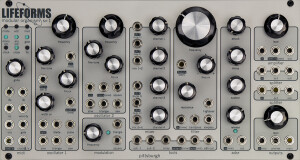
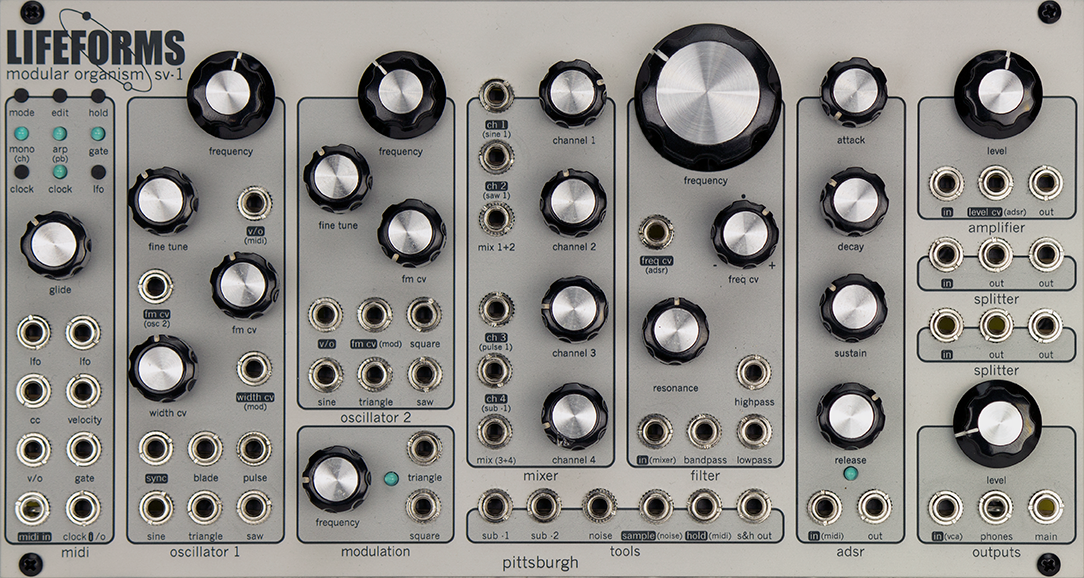
![[NAMM] Nouveaux Lifeforms chez Pittsburgh Modular](https://img.audiofanzine.com/img/product/normal/2/4/248658.png?fm=pjpg&w=116&s=28552dcc7f9ec6b0edadd0df3b5a270a)
